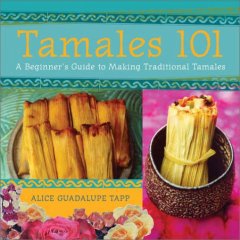
Tamales to a Mexican is what roast beef is to most Americans: It's something you eat on special occassions. In my family, we usually have a tamale party before Christmas. In a tamale party most of the my (female) cousins and aunts gather at my grandmother's house and we start an assembly line and we make enough tamales to feed an army. As you can imagine, the process of making the tamales is a long one, so nowadays it's much easier to buy our tamales from various tamale vendors in the San Diego area.
The best tamales I've had so far were from Mercado Internacional in Chula Vista, California. My husband, Matthew, couldn't get enough of the Rajas con Quese (jalapeño slices with cheese) tamales or the Tamales Dulce de Piña (sweet pineapple tamales).
But what is a tamale? The original pre-Hispanic tamales were made by plac ing some uncooked masa (tortilla dough) on a fresh or dried and rehydrated corn husk, adding a filling of meat, seafood, insects, vegetables or fruit, wrapping the husk into a package and steaming it. Following the introduction of lard by the Spanish, this fat was added to the dough which makes it much lighter, and more savory. Tamales are also made with fresh ground corn. And on a side note: DO NOT EAT THE HUSK. I know a couple people who have tried to eat the husk and, I'm told, it's not a very pleasant taste.
ing some uncooked masa (tortilla dough) on a fresh or dried and rehydrated corn husk, adding a filling of meat, seafood, insects, vegetables or fruit, wrapping the husk into a package and steaming it. Following the introduction of lard by the Spanish, this fat was added to the dough which makes it much lighter, and more savory. Tamales are also made with fresh ground corn. And on a side note: DO NOT EAT THE HUSK. I know a couple people who have tried to eat the husk and, I'm told, it's not a very pleasant taste.
I found several good websites on making tamales and its history. There is also a great book called, Tales 101: A Beginner's Guide to Making Traditional Tamales. If you're planning on making tamales and/or making tamales a part of your family tradition, this is the book to buy. To see other resources and recipes, check out
Gourmet Sleuth.com.
No comments:
Post a Comment